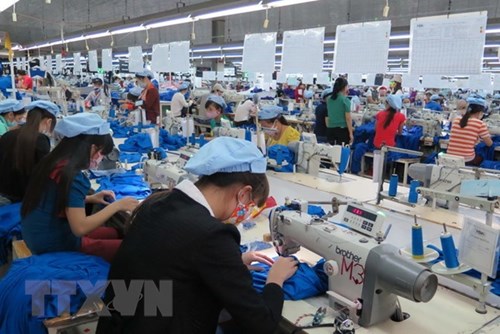This is considered a good start for the industry to realize its export target of USD 35 billion by the end of this year.
President of the Ho Chi Minh City Association of Garment and Textile (AGTEK) Pham Xuan Hong said the sector has bright prospects this year.
    |
 |
|
Garment-textile export turnover reached nearly USD 8 billion in the first quarter of 2018, a year-on-year rise of 13.3 percent |
Garment-textile exports in 2018 are anticipated to be better than in 2017 with the maintenance of two-digit growth.
Chairman of the Directors Board of Hung Yen Garment Corporate Nguyen Xuan Duong said the number of orders is likely to strongly increase this year, especially for large-scale businesses.
Most domestic enterprises have orders until the second of quarter of 2018. Some have even received orders for the third quarter, he said.
According to Chairman of the Vietnam Textile and Apparel Association Vu Duc Giang, Vietnamese garment-textile businesses can compete in the region thanks to the sharpened skills of workers, improved productivity and better quality of products.
Domestic enterprises have also invested in new technology to increase productivity and competitiveness, he said.
Free trade agreements not only help the garment-textile sector diversify export markets but also reduce imports of material, he said, adding that currently Vietnam exports more than USD 3 billion worth of yarn, nearly USD 1 billion worth of fabric and USD 400 million worth of garment accessories each year.
Industry 4.0 has changed the mindset of businesses in regards to technology investment, Giang said, noting that businesses are looking to high value production segments such as Original Design Manufacturing and Own Brand Manufacturing.
Garment-textile companies also focus on the development of human resources and cutting edge technology, he said.
Some big enterprises such as Phong Phu Joint Stock Company and Garment-10 Joint Stock Company are seeking to export through online sales, he added.
However, the Vietnam Textile & Apparel Association has warned businesses of numerous challenges, including fiercer competition from other countries like China, Myanmar and Cambodia.
The association advised enterprises to improve skills of workers and reform management methods to increase productivity.
Apart from maintaining and developing exports to key markets such as the US, EU, Japan and the Republic of Korea, businesses should expand to other markets such as the Association of Southeast Asian Nations, Eurasian Economic Union, India and Latin American countries.
Source: VNA